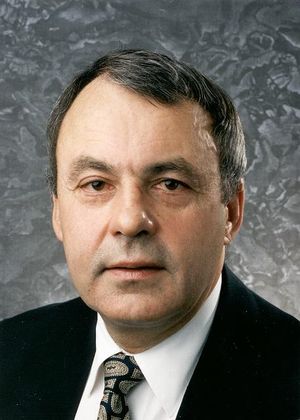Gottfried Ungerboeck
- Birthdate
- 1940/03/15
- Birthplace
- Vienna, Austria
- Associated organizations
- IBM
- Fields of study
- Signal processing
- Awards
- IEEE Richard W. Hamming Medal
Biography
Gottfried Ungerboeck was born on March 15, 1940 in Vienna, Austria. He obtained the Dipl. Ing. degree from the Technical University of Vienna in 1964 and the Ph.D. degree from the Swiss Federal Institute of Technology in Zurich in 1970, both in Electrical Engineering.
Dr. Ungerboeck's first professional association was with Wiener Schwachstromwerke in Vienna. In 1965, he joined IBM Austria where he was a systems engineer for technical computer applications. In 1967, Dr. Ungerboeck became a research staff member at the IBM Zurich Research Laboratory in Rueschlikon, Switzerland. Initially, his research dealt with digital speech processing, and later with switching systems. After receiving the Ph.D. degree in 1970 with a thesis on optimum receivers for data communication.
Dr. Ungerboeck continued to investigate problems in signal detection, equalization, and synchronization. During the mid 1970's, he began to realize the potential of combining coding and modulation. In 1977, he developed the first of several digital signal processors and started to engage in their applications, in particular for voiceband modems. Work on satellite transmission and magnetic recording followed. Since 1978, Dr. Ungerboeck has managed signal processing activities at the IBM Zurich Research Laboratory. He presently heads a group dealing with high-speed transmission over unshielded twisted-pair cables.
Dr. Ungerboeck has pioneered several new signal processing techniques for digital data transmission and storage. Most well known is his invention of trellis coded modulation (TCM). Prior to TCM, error correction coding and modulation were considered as separate fields. The error performance of data links could be improved by error correction coding only at the expense of lowering the effective data rate or requiring more bandwidth. With TCM, the functions of convolutional coding and modulation are combined in a manner that maximizes the free Euclidean distance between sequences of modulation symbols. The data rate and bandwidth of an uncoded system is maintained by choosing the modulation symbols from a redundant, in general nonbinery signal constellation. Mapping code symbols into modulation symbols by set partitioning plays a central role. With simple TCM schemes, coding gains of at least 3 dB are obtained over uncoded modulation, and gains of up to 6 dB are achieved with-more complexity. Soon after the publication of TCM in 1982, combined coding and modulation became a very active research area and found widespread applications throughout the field of digital transmission.
Dr. Ungerboeck holds 15 patents and has published extensively in the field. He is a Fellow of the IEEE and an IBM Fellow. He was a co-recipient of the IEEE Information Theory Society Best Paper Award (1984), recipient of the IEEE Communications Society Edwin H. Armstrong Award (1986), the Swiss Information Society Best Paper Award (1988), and the IEEE Koji Kobayashi Computers and Communications Award (1993). He received an honorary doctoral degree from the Technical University of Vienna, Austria.
Dr. Ungerboeck and his wife, Sonni, have two children, Andrea and Iris. His nonprofessional interests include sailing as a yacht skipper during yearly ocean cruises.
